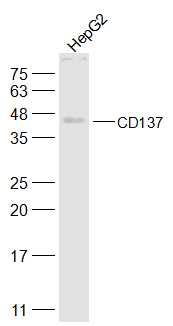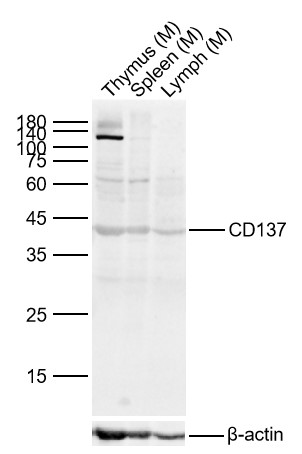
Rabbit Anti-CD137 antibody
Tumor necrosis factor receptor superfamily member 9; TNFRSF9; 4-1BB; 4 1BB; 4 1BB ligand receptor; Homolog of mouse 4 1BB; Receptor protein 4 1BB; T cell antigen 4 1BB homolog; T cell antigen ILA; CDw137; CD 137; CD137 antigen; Induced by lymphocyte activ
View History [Clear]
Details
Product Name CD137 Chinese Name Tumour坏死因子受体超家族成员9抗体 Alias Tumor necrosis factor receptor superfamily member 9; TNFRSF9; 4-1BB; 4 1BB; 4 1BB ligand receptor; Homolog of mouse 4 1BB; Receptor protein 4 1BB; T cell antigen 4 1BB homolog; T cell antigen ILA; CDw137; CD 137; CD137 antigen; Induced by lymphocyte activation; ILA; Interleukin activated receptor homolog of mouse Ly63; Ly63; MGC2172; MGC114552; OTTHUMP00000044294; TNR9_HUMAN. literatures Research Area Tumour Cell biology immunology Apoptosis The cell membrane受体 Natural killer cells t-lymphocyte Immunogen Species Rabbit Clonality Polyclonal React Species Human, Mouse, Applications WB=1:500-2000 ELISA=1:5000-10000
not yet tested in other applications.
optimal dilutions/concentrations should be determined by the end user.Theoretical molecular weight 25kDa Cellular localization The cell membrane Form Liquid Concentration 1mg/ml immunogen KLH conjugated synthetic peptide derived from human CD137: 101-200/255 Lsotype IgG Purification affinity purified by Protein A Buffer Solution 0.01M TBS(pH7.4) with 1% BSA, 0.03% Proclin300 and 50% Glycerol. Storage Shipped at 4℃. Store at -20 °C for one year. Avoid repeated freeze/thaw cycles. Attention This product as supplied is intended for research use only, not for use in human, therapeutic or diagnostic applications. PubMed PubMed Product Detail CD137 exists on the cell surface as a monomer with a molecular mass of 30 kDa and as a dimer of 55 kDa. Human and mouse CD137 share 60% amino acid identity. CD137 (4-1BB), a member of the tumour necrosis factor receptor superfamily, is a type I transmembrane glycoprotein expressed on the cell surface of activated splenic T cells and thymocytes. The functions of CD137 in T lymphocytes include regulating activation, proliferation and apoptosis. CD137 and CD28 are costimulatory molecules of T cell activation. Costimulatory molecules are important in initiating anti-tumor immune responses. CD137 plays an important role in regulating T-cell-dependent immune responses. Expression of CD137 correlates negatively with lymphocyte proliferation and positively with the degree of activation-induced cell death caused by mitogen overstimulation. In monocytes, CD137 induces activation, promotes adherence and prolongs survival.
Function:
Receptor for TNFSF9/4-1BBL. Possibly active during T cell activation.
Subunit:
Interacts with TRAF1, TRAF2 and TRAF3. Interacts with LRR-repeat protein 1/LRR-1.
Subcellular Location:
Membrane; Single-pass type I membrane protein.
Tissue Specificity:
Expressed on the surface of activated T-cells.
Similarity:
Contains 4 TNFR-Cys repeats.
SWISS:
Q07011
Gene ID:
3604
Database links:Entrez Gene: 3604 Human
Omim: 602250 Human
SwissProt: Q07011 Human
Unigene: 654459 Human
CD137属于Tumour坏死因子超家族成员,是可诱导的T细胞共刺激受体,表达于CD4 + 和CD8 + T细胞、活化的Natural killer cells(natural killercell,NK)和树突状细胞,CD137可抑制T细胞增殖,诱发Apoptosis。Product Picture
HepG2(Human) Cell Lysate at 30 ug
Primary: Anti-CD137 (SL2449R) at 1/500 dilution
Secondary: IRDye800CW Goat Anti-Rabbit IgG at 1/20000 dilution
Predicted band size: 25 kD
Observed band size: 39 kD
References (0)
No References
Bought notes(bought amounts latest0)
No one bought this product
User Comment(Total0User Comment Num)
- No comment




 +86 571 56623320
+86 571 56623320
 +86 18668110335
+86 18668110335

